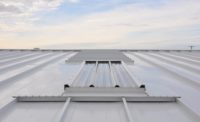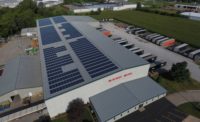To meet the demands of stringent codes, Morin, A Kingspan Group Company, has introduced the SymmeTry Roof Series, a mechanically seamed structural roof system that is both symmetrical and hydrostatic by design.
The options and advantages of a symmetrical system over an asymmetrical system are many and during the next few years, symmetrical roof systems will revolutionize our industry.
Currently, there are only a handful of metal roofing manufacturers offering a symmetrical panel profile and fewer with the technical know-how to provide solutions to difficult roofing problems. MORIN’s SymmeTry Roof Series has four panel depths – more than other manufacturers – and three coverage widths, making it a versatile system offering for architects, specifiers, roofing consultants and installers.
Symmetrical Advantages
A symmetrical metal roofing system does not “lap” over an adjacent panel like standard asymmetrical panels. Symmetrical panels install side by side and have a mechanically seamed “cap” that has two beads of continuous (without interruption by panel clip) butyl sealant, creating the most water tight seam of all metal panel types. MORIN’s SymmeTry Roof Series vertical panel legs range from 1-1/2 inches to 3 inches in height.
The SymmeTry Roof Series panels, by design, are bidirectional, meaning they can be installed going left to right, right to left, or start from any point of the roof.
In the event a panel needs to be replaced because it’s damaged or large penetrations need to be added after the installation, panel replacement is easier and less expensive with a symmetrical panel. Building owners only have to replace the panel or panels affected by damage or new penetrations and install a new seam cap.
Symmetrical panels are specified and installed to allow for unlimited thermal expansion and contraction, providing the advantage of installing panels up to 300 feet in length. The clips are fixed and the panels move up and down the slope engaging on the clips rather than the clips sliding and running out of expansion capacity. These panels can be formed onsite. By eliminating end laps, and ensuring a proper installation by qualified installers, leaks are greatly reduced and/or eliminated completely.
More Savings Benefits
A symmetrical roofing system is ideal for roofs with complex geometry. The system installs easier. It’s also an ideal system to install when an existing roof needs to be recovered. The space between the existing roof and the new symmetrical panels can be filled with insulation, increasing the R-value.
The clips used for a symmetrical roof system have a 3/8-inch offset. This allows for airflow between the panels and the existing roof, reducing heat transfer significantly, lowering the overall temperature of the roof envelope.
In a recover application, the installation of a symmetrical system eliminates the growing cost of tear-off and disposal.
In a remove and replace application, the savings of using a symmetrical system as opposed to an asymmetrical system, can be tremendous. In a 90,000 square foot building, to meet the updated wind uplift requirements in many regions with a new roof, you would be required to add as much as 10,000 lineal feet of additional purlins to the structure when using an asymmetrical standing seam system. With wind uplift capabilities of the symmetrical system, you would not have to add any.
Simply, at the end of the day, it’s the lowest cost of ownership.
Tested Benefits
Each manufacturer of symmetrical standing seam roof systems will have its panels tested. The SymmeTry Roof Series from MORIN has undergone or is undergoing a wide variety of tests that will allow for its installation anywhere, including where the strictest wind uplift codes and wind driven rain requirements are in place.
MORIN’s taller panels (2-1/2- and 3-inch legs) will meet requirements to be installed at very low slopes. It will meet ASTM E-1680 air infiltration, ASTM E-1646 water infiltration and ASTM E-2140 static water pressure requirements, which means the panel can be flooded and it won’t leak.
The SymmeTry Roof Series system is undergoing (and expected to meet the requirements of):
- ASTM E-1592 Uplift Test
- UL 580 and UL 1897 Wind Uplift Test
- UL Class A Fire Rating
- UL Class 4 Impact Resistance
- FM 4471 Open Framing Uplift Test
- FM 4471 Over Metal Deck Uplift Test
- ASTM E-1680 Air Infiltration Test
- ASTM E-1646 Water Infiltration Test
- ASTM E-2140 Static Water Pressure
- FM Class 1-SH Impact Resistance Test
- Florida Products Approval
- Texas Windstorm
In past years, everyone was specifying and installing the snap-lock standing seam system. Then codes got stricter and everyone migrated to a 2-inch single- or double-lock standing seam roof system. There will be a migration to symmetrical roof systems over an asymmetrical system simply because of the significant wind uplift capacities. The symmetrical roof systems have greater wind uplift capabilities than any asymmetrical panel system.
Symmetrical roofing systems could be a game-changer in the industry, especially where Miami-Dade Code approvals and Florida Product Approvals are required. Symmetrical roofing systems could be beneficial anywhere complex roof systems require very low slope applications as well as within the growing retrofit segment, where recover and remove-and-replace opportunities exist.


